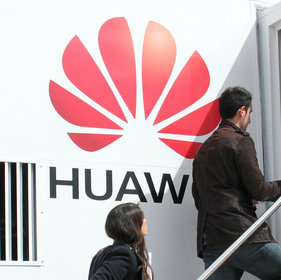
Huawei says it will invest $800 million in 5G research and development this year as it strives to become a pioneer of the next-generation mobile technology.
The Chinese vendor spent about $12 billion on R&D last year and today made a commitment to invest between $10 billion and $20 billion annually in future.
The spending commitment dwarfs the R&D investments that Huawei's chief rivals made last year: Ericsson AB (Nasdaq: ERIC) reported about $4.1 billion in net R&D expenses in 2017, and Nokia Corp. (NYSE: NOK) forked out approximately $4.6 billion.
Huawei's 5G investments alone would represent nearly a fifth of Ericsson's overall R&D spending last year.
Nokia, meanwhile, has already warned investors that 5G investments will squeeze its profitability this year. It is guiding for an operating margin of between 9% and 11% in 2018, down from 15.1% in the last three months of 2017, when it saw operating profits at its networks business shrink by one quarter compared with the year-earlier period.
Huawei, which in 2015 overtook Ericsson to become the world's largest supplier to communications service providers, unveiled details of its 5G strategy at a press event in London this morning. (See Huawei: New King of the CSP Market.)
Peter Zhou, the chief marketing officer of Huawei's wireless product line, said the company has been working on 5G for more than a decade and has recruited more than 300 5G experts worldwide to lead the development of the technology.
Huawei Technologies Co. Ltd. already claims to have established a leadership position in the field of massive MIMO, which uses large numbers of active antennas to boost mobile network performance. It has now shipped more than 20,000 massive MIMO units for more than 40 networks based on 4G technology, said the company.
Analysts say the Chinese vendors, which include Huawei as well as smaller rival ZTE, have raced ahead of Ericsson and Nokia in massive MIMO because the technology was originally intended for the time division duplex (TDD) networks that are widely used in the Chinese market. Operators in North America and Europe have tended to prefer the alternative frequency division duplex (FDD) system.
Zhou also told reporters that Huawei would announce some "end-to-end" 5G products at the forthcoming Mobile World Congress trade show in Barcelona later this month, including innovations in core, transmission and radio networks, as well as on the devices side.
It continues to develop radio access networks that can support multiple technology generations and spectrum bands, and is forecasting 100 billion 5G device connections by 2025.
Want to know more about 5G? Check out our dedicated 5G content channel here on
Light Reading.
But Huawei executives also urged European governments to provide more support to operators investing in 5G networks.
Globally, Huawei estimates operators' capital expenditure to be between $300 billion and $330 billion annually, with a fairly even split between investments in "active" network systems and spending on "passive" facilities.
Its expectation, however, is that operators will need greater access to passive facilities as they roll out their 5G networks. "The government role will be to help carriers reduce these investments in facilities," said Ryan Ding, the president of Huawei's carrier business group. "The Irish government is encouraging carriers to work with electricity companies, for example, and Spain is encouraging public-private partnerships to reduce investments in facilities."
Ding also criticized European governments for overcharging operators during the sale of spectrum licenses, suggesting this could slow down the rollout of 5G networks. "The cost of spectrum in Europe is still too high," he said. "With a more reasonable range, carriers would have more capital to invest in deploying 5G."
The remarks betray some concern that the 5G rollout could take many years in some parts of the world, as operators continue to rely on the 4G networks they have already built.
In Germany, the announcement of plans for a 5G spectrum auction later this year has provoked jitters among the country's operators. Companies including Deutsche Telekom AG (NYSE: DT) and Telefónica Deutschland GmbH have reportedly expressed concern that authorities may charge exorbitant rates for those licenses and attach onerous conditions to them. (See Germany's 5G Auction & the Gigabit Dream.)
Huawei further acknowledged that backhaul remains a big challenge in the European market, where it estimates fiber coverage is only between 30% and 50%. (See Europe's Backhaul Black Hole Looms Above 5G.)
With 5G services, operators will increasingly need access to high-speed fixed lines for the "backhaul" connections between basestations and core networks. "How to deal with that is a challenge carriers need to figure out," said Ding.
One idea is to use a 5G-enabled microwave technology where fiber is unavailable, he said.
Huawei's update comes after the 3GPP locked down its specifications for 5G New Radio technology at the end of 2017. Using 5G New Radio, operators will be able to roll out a "non-standalone" version of 5G technology that relies on a 4G core network. (See 5G Is Official: First 3GPP Specs Approved.)
Specifications for a "standalone" variant that includes core network features are due to be frozen in June. "Countries may choose standalone or non-standalone but 5G networks will eventually move to standalone," said Zhou. "That is why compatibility is required for devices and equipment."
French telco Orange (NYSE: FTE) this week said it was not yet clear how operators investing in non-standalone 5G networks would manage the transition to standalone 5G in future. (See Huawei Frozen Out of Orange's 5G Paris Party.)
— Iain Morris, News Editor, Light Reading
About the Author(s)
You May Also Like




_International_Software_Products.jpeg?width=300&auto=webp&quality=80&disable=upscale)







